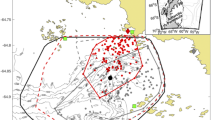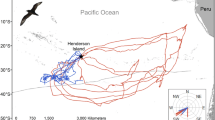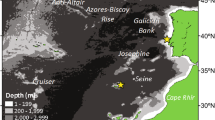Abstract
Finding food is crucial to the survival and reproductive success of individuals. Fidelity to previous profitable foraging sites may bring benefits to individuals as they can allocate more time to foraging rather than searching for prey. We studied how environmental conditions influence when lactating long-nosed fur seals (Arctocephalus forsteri) adopt a risky (low fidelity) or conservative (high fidelity) foraging strategy at two intra-annual temporal scales when foraging in a highly variable oceanic environment. Core foraging areas (CFAs; n = 534; 30 × 30 km cells) of consecutive foraging trips were obtained from geolocation tracks of 12 females from summer to winter in 2016 (n = 5) and 2017 (n = 7). We used the spatial variability (standard deviation) of CFAs between or among oceanic foraging trips as a proxy for individual foraging site fidelity (IFSF). Over the entire oceanic foraging period (n = 12), IFSF in the latitudinal axis increased with stronger sea-surface temperature gradient (SSTgrad), but decreased with greater SSTgrad and sea-surface height gradient variability. Over a period of two consecutive oceanic foraging trips (n = 66), IFSF decreased with greater SSTgrad variability in the earlier foraging trip. LNFS show evidence that they use IFSF as a strategy to potentially optimise food acquisition, and that this behaviour is influenced by mesoscale oceanographic parameters.




Similar content being viewed by others
Data availability
The datasets analysed during the current study are available from the corresponding author on a reasonable request.
References
Abrahms B, Hazen EL, Bograd SJ, Brashares JS, Robinson PW, Scales KL, Crocker DE, Costa DP (2018a) Climate mediates the success of migration strategies in a marine predator. Ecol Lett 21:63–71. https://doi.org/10.1111/ele.12871
Abrahms B, Scales KL, Hazen EL, Bograd SJ, Schick RS, Robinson PW, Costa DP (2018b) Mesoscale activity facilitates energy gain in a top predator. Proc R Soc B Biol Sci 285:20181101. https://doi.org/10.1098/rspb.2018.1101
Arthur B, Hindell M, Bester M, Trathan P, Jonsen I, Staniland I, Oosthuizen WC, Wege M, Lea MA (2015) Return customers: foraging site fidelity and the effect of environmental variability in wide-ranging antarctic fur seals. PLoS ONE 10:e0120888. https://doi.org/10.1371/journal.pone.0120888
Bailey H, Thompson P (2010) Effect of oceanographic features on fine-scale foraging movements of bottlenose dolphins. Mar Ecol Prog Ser 418:223–233. https://doi.org/10.3354/meps08789
Bailleul F, Cotté C, Guinet C (2010) Mesoscale eddies as foraging area of a deep-diving predator, the southern elephant seal. Mar Ecol Prog Ser 408:251–264. https://doi.org/10.3354/meps08560
Baylis AMM, Page B, Goldsworthy SD (2008) Effect of seasonal changes in upwelling activity on the foraging locations of a wide-ranging central-place forager, the New Zealand fur seal. Can J Zool 86:774–789. https://doi.org/10.1139/Z08-055
Baylis AMM, Page B, McKenzie J, Goldsworthy SD (2012) Individual foraging site fidelity in lactating New Zealand fur seals: continental shelf vs. oceanic habitats. Mar Mammal Sci 28:276–294. https://doi.org/10.1111/j.1748-7692.2011.00487.x
Belkin IM, Cornillon PC, Sherman K (2009) Fronts in large marine ecosystems. Prog Oceanogr 81:223–236. https://doi.org/10.1016/j.pocean.2009.04.015
Bonadonna F, Lea MA, Dehorter O, Guinet C (2001) Foraging ground fidelity and route-choice tactics of a marine predator: The Antarctic fur seal Arctocephalus gazella. Mar Ecol Prog Ser 223:287–297. https://doi.org/10.3354/meps223287
Bost CA, Cotte C, Bailleul F, Cherel Y, Charrassin JB, Guinet C, Ainley DG, Weimerskirch H (2009) The importance of oceanographic fronts to marine birds and mammals of the southern oceans. J Mar Syst 78:363–376. https://doi.org/10.1016/j.jmarsys.2008.11.022
Boyd IL (1999) Foraging and provisioning in Antarctic fur seals: interannual variability in time-energy budgets. Behav Ecol 10:198–208. https://doi.org/10.1093/beheco/10.2.198
Bradshaw C, Higgins J, Michael K, Wotherspoon S, Hindell M (2004) At-sea distribution of female southern elephant seals relative to variation in ocean surface properties. Ices J Mar Sci 61:1014–1027. https://doi.org/10.1016/j.icesjms.2004.07.012
Burkanov V, Gurarie E, Altukhov A, Mamaev E, Permyakov P, Trukhin A, Waite J, Gelatt T (2011) Environmental and biological factors influencing maternal attendance patterns of Steller sea lions (Eumetopias jubatus) in Russia. J Mammal 92:352–366. https://doi.org/10.1644/10-MAMM-A-194.1
Burnham KP, Anderson DR (2002) Model selection and multimodel inference: a practical information-theoretic approach, 2nd edn. Springer, New York
Call KA, Ream RR, Johnson D, Sterling JT, Towell RG (2008) Foraging route tactics and site fidelity of adult female northern fur seal (Callorhinus ursinus) around the Pribilof Islands. Deep Sea Res Part II Top Stud Oceanogr 55:1883–1896. https://doi.org/10.1016/j.dsr2.2008.04.022
Campagna C, Piola AR, Rosa M, Lewis M, Fernández T (2006) Southern elephant seal trajectories, fronts and eddies in the Brazil/Malvinas Confluence. Deep Res Part I Oceanogr Res Pap 53:1907–1924. https://doi.org/10.1016/j.dsr.2006.08.015
Chambault P, Roquet F, Benhamou S, Baudena A, Pauthenet E, de Thoisy B, Bonola M, Dos Reis V, Crasson R, Brucker M, Le Maho Y, Chevallier D (2017) The Gulf Stream frontal system: a key oceanographic feature in the habitat selection of the leatherback turtle? Deep Res Part I Oceanogr Res Pap 123:35–47. https://doi.org/10.1016/j.dsr.2017.03.003
Charnov EL (1976) Optimal foraging, marginal value theorem. Theor Popul Biol 9:129–136. https://doi.org/10.1016/0040-5809(76)90040-x
Cleeland JB, Lea MA, Hindell MA (2014) Use of the Southern Ocean by breeding short-tailed shearwaters (Puffinus tenuirostris). J Exp Mar Bio Ecol 450:109–117. https://doi.org/10.1016/j.jembe.2013.10.012
Cotté C, Park YH, Guinet C, Bost CA (2007) Movements of foraging king penguins through marine mesoscale eddies. Proc R Soc B Biol Sci 274:2385–2391. https://doi.org/10.1098/rspb.2007.0775
Croll DA, Demer DA, Hewitt RP, Jansen JK, Goebel ME, Tershy BR (2006) Effects of variability in prey abundance on reproduction and foraging in chinstrap penguins (Pygoscelis antarctica). J Zool 269:506–513. https://doi.org/10.1111/j.1469-7998.2006.00090.x
Della Penna A, De Monte S, Kestenare E, Guinet C, D’Ovidio F (2015) Quasi-planktonic behavior of foraging top marine predators. Sci Rep 5:18063. https://doi.org/10.1038/srep18063
Douglass EM, Richman JG (2015) Analysis of ageostrophy in strong surface eddies in the Atlantic Ocean. J Geophys Res Ocean 120:1490–1507. https://doi.org/10.1002/2014JC010350
Espinoza M, Farrugia TJ, Lowe CG (2011) Habitat use, movements and site fidelity of the gray smooth-hound shark in a restored California estuary. J Exp Mar Bio Ecol 401:63–74. https://doi.org/10.1016/j.jembe.2011.03.001
Foo D, McMahon C, Hindell M, Goldsworthy S, Bailleul F (2019) Influence of shelf oceanographic variability on alternate foraging strategies in long-nosed fur seals. Mar Ecol Prog Ser 615:189–204. https://doi.org/10.3354/meps12922
Gaube P, Chelton DB, Samelson RM, Schlax MG, O’Neill LW (2015) Satellite observations of mesoscale eddy-induced ekman pumping. J Phys Oceanogr 45:104–132. https://doi.org/10.1175/jpo-d-14-0032.1
Gaube P, Barcelo C, McGillicuddy DJ, Domingo A, Miller P, Giffoni B, Marcovaldi N, Swimmer Y (2017) The use of mesoscale eddies by juvenile loggerhead sea turtles (Caretta caretta) in the southwestern Atlantic. PLoS ONE 12:e0172839. https://doi.org/10.1371/journal.pone.0172839
Georges JY, Guinet C (2000) Maternal care in the Subantarctic fur Seals on Amsterdam Island. Ecology 81:295–308. https://doi.org/10.1890/0012-9658(2000)081[0295:MCITSF]2.0.CO;2
Goldsworthy SD (2006) Maternal strategies of the New Zealand fur seal: evidence for interannual variability in provisioning and pup growth strategies. Aust J Zool 54:31–44. https://doi.org/10.1071/ZO05041
Goldsworthy SD, Bailleul F, Shaughnessy PD, Mackay AI, Reinhold S-L, Stonnill M, Lashmar K (2016) Monitoring of pinniped populations on Kangaroo Island: 2015/16. Report to the Department of Environment Water and Natural Resources, London
Guinet C, Dubroca L, Lea MA, Goldsworthy S, Cherel Y, Duhamel G, Bonadonna F, Donnay JP (2001) Spatial distribution of foraging in female Antarctic fur seals Arctocephalus gazella in relation to oceanographic variables: a scale-dependent approach using geographic information systems. Mar Ecol Prog Ser 219:251–264. https://doi.org/10.3354/meps219251
Hijmans RJ, van Etter J, Cheng J, Mattiuzzi M, Summer M, Greenberg JA, Lamigueiro OP, Bevan A, Racine EB, Shortridge A, Ghosh A (2017) Geographic data analysis and modeling. https://cran.r-project.org/web/packages/raster/index.html. Accessed 3 Mar 2019
Houston AI, Stephens PA, Boyd IL, Harding KC, McNamara JM (2007) Capital or income breeding? A theoretical model of female reproductive strategies. Behav Ecol 18:241–250. https://doi.org/10.1093/beheco/arl080
James C, Tomczak M, Helmond I, Pender L (2002a) Summer and winter surveys of the subtropcal front of the southeastern Indian Ocean 1997–1998. J Mar Syst 37:129–149. https://doi.org/10.1016/s0924-7963(02)00199-9
James C, Tomczak M, Helmond I, Pender L (2002b) Summer and winter surveys of the Subtropical Front of the southeastern Indian Ocean 1997–1998. J Mar Syst 37:129–149. https://doi.org/10.1016/s0924-7963(02)00199-9
Johnston DW, Thorne LH, Read AJ (2005) Fin whales Balaenoptera physalus and minke whales Balaenoptera acutorostrata exploit a tidally driven island wake ecosystem in the Bay of Fundy. Mar Ecol Prog Ser 305:287–295. https://doi.org/10.3354/meps305287
Kotliar NB, Wiens JA (1990) Multiple scales of patchiness and patch structure: a hierarchical framework for the study of heterogeneity. Oikos 59:253. https://doi.org/10.2307/3545542
Kowalczyk ND, Reina RD, Preston TJ, Chiaradia A (2015) Environmental variability drives shifts in the foraging behaviour and reproductive success of an inshore seabird. Oecologia 178:967–979. https://doi.org/10.1007/s00442-015-3294-6
Lisovski S, Hahn S, Hodgson D (2012) GeoLight- processing and analysing light-based geolocator data inR. Methods Ecol Evol 3:1055–1059. https://doi.org/10.1111/j.2041-210X.2012.00248.x
McHuron EA, Hazen E, Costa DP (2018) Constrained by consistency? Repeatability of foraging behavior at multiple timescales for a generalist marine predator. Mar Biol 165:122. https://doi.org/10.1007/s00227-018-3382-3
McIntyre T, Bester MN, Bornemann H, Tosh CA, de Bruyn PJN (2017) Slow to change? Individual fidelity to three-dimensional foraging habitats in southern elephant seals, Mirounga leonina. Anim Behav 127:91–99. https://doi.org/10.1016/j.anbehav.2017.03.006
McKenzie J, Parry LJ, Page B, Goldsworthy SD (2005) Estimation of pregnancy rates and reproductive failure in New Zealand Fur Seals (Arctocephalus Forsteri). J Mammal 86:1237–1246. https://doi.org/10.1644/05-mamm-a-085r.1
McMahon CR, Hindell MA, Burton HR, Bester MN (2005) Comparison of southern elephant seal populations, and observations of a population on a demographic knife-edge. Mar Ecol Prog Ser 288:273–283. https://doi.org/10.3354/meps288273
Middleton JF, Bye JAT (2007) A review of the shelf-slope circulation along Australia’s southern shelves: Cape Leeuwin to Portland. Prog Oceanogr 75:1–41. https://doi.org/10.1016/j.pocean.2007.07.001
Miller PI, Scales KL, Ingram SN, Southall EJ, Sims DW (2015) Basking sharks and oceanographic fronts: quantifying associations in the north-east Atlantic. Funct Ecol 29:1099–1109. https://doi.org/10.1111/1365-2435.12423
Nordstrom CA, Battaile BC, Cotté C, Trites AW (2013) Foraging habitats of lactating northern fur seals are structured by thermocline depths and submesoscale fronts in the eastern Bering Sea. Deep Sea Res Part II Top Stud Oceanogr 88–89:78–96. https://doi.org/10.1016/j.dsr2.2012.07.010
Oke PR, Griffin DA, Rykova T, de Oliveira HB (2018) Ocean circulation in the Great Australian Bight in an eddy-resolving ocean reanalysis: the eddy field, seasonal and interannual variability. Deep Res Part II Top Stud Oceanogr 157–158:11–26. https://doi.org/10.1016/j.dsr2.2018.09.012
Oksanen SM, Ahola MP, Lehtonen E, Kunnasranta M (2014) Using movement data of Baltic grey seals to examine foraging-site fidelity: implications for seal-fishery conflict mitigation. Mar Ecol Prog Ser 507:297–308. https://doi.org/10.3354/meps10846
Oosthuizen WC, Bester MN, Altwegg R, McIntyre T, De Bruyn PJN (2015) Decomposing the variance in Southern Elephant seal weaning mass: partitioning environmental signals and maternal effects. Ecosphere 6:1–22. https://doi.org/10.1890/ES14-00508.1
Page B, McKenzie J, Goldsworthy SD (2005) Inter-sexual differences in New Zealand fur seal diving behaviour. Mar Ecol Prog Ser 304:249–264. https://doi.org/10.3354/meps304249
Page B, McKenzie J, Sumner MD, Coyne M, Goldsworthy SD (2006) Spatial separation of foraging habitats among New Zealand fur seals. Mar Ecol Prog Ser 323:263–279. https://doi.org/10.3354/meps323263
Pettex E, Lorentsen SH, Grémillet D, Gimenez O, Barrett RT, Pons JB, Le Bohec C, Bonadonna F (2012) Multi-scale foraging variability in Northern gannet (Morus bassanus) fuels potential foraging plasticity. Mar Biol 159:2743–2756. https://doi.org/10.1007/s00227-012-2035-1
Pichegru L, Ryan PG, Crawford RJM, van der Lingen CD, Grémillet D (2010) Behavioural inertia places a top marine predator at risk from environmental change in the Benguela upwelling system. Mar Biol 157:537–544. https://doi.org/10.1007/s00227-009-1339-2
Polovina JJ, Balazs GH, Howell EA, Parker DM, Seki MP, Dutton PH (2004) Forage and migration habitat of loggerhead (Caretta caretta) and olive ridley (Lepidochelys olivacea) sea turtles in the central North Pacific Ocean. Fish Oceanogr 13:36–51. https://doi.org/10.1046/j.1365-2419.2003.00270.x
Rayner MJ, Hartill BW, Hauber ME, Phillips RA (2010) Central place foraging by breeding Cook’s petrel Pterodroma cookii: foraging duration reflects range, diet and chick meal mass. Mar Biol 157:2187–2194. https://doi.org/10.1007/s00227-010-1483-8
R Core Team (2019) R: a language and environment for statistical computing.
Reisinger RR, Raymond B, Hindell MA, Bester MN, Crawford RJM, Davies D, de Bruyn PJN, Dilley BJ, Kirkman SP, Makhado AB, Ryan PG, Schoombie S, Stevens K, Sumner MD, Tosh CA, Wege M, Whitehead TO, Wotherspoon S, Pistorius PA (2018) Habitat modelling of tracking data from multiple marine predators identifies important areas in the Southern Indian Ocean. Divers Distrib 24:535–550. https://doi.org/10.1111/ddi.12702
Scales KL, Miller PI, Embling CB, Ingram SN, Pirotta E, Votier SC (2014) Mesoscale fronts as foraging habitats: composite front mapping reveals oceanographic drivers of habitat use for a pelagic seabird. J R Soc Interface 11:20140679–20140679. https://doi.org/10.1098/rsif.2014.0679
Simmons SE, Crocker DE, Kudela RM, Costa DP (2007) Linking foraging behaviour of the northern elephant seal with oceanography and bathymetry at mesoscales. Mar Ecol Prog Ser 346:265–275. https://doi.org/10.3354/meps07014
Sokolov S, Rintoul SR (2007) Multiple jets of the antarctic circumpolar current South of Australia. J Phys Oceanogr 37:1394–1412. https://doi.org/10.1175/JPO3111.1
Sommerfeld J, Kato A, Ropert-Coudert Y, Garthe S, Wilcox C, Hindell MA (2015) Flexible foraging behaviour in a marine predator, the Masked booby (Sula dactylatra), according to foraging locations and environmental conditions. J Exp Mar Bio Ecol 463:79–86. https://doi.org/10.1016/j.jembe.2014.11.005
Staniland IJ, Boyd IL (2003) Variation in the foraging location of Antarctic fur seals (Arctocephalus gazella) and the effects on diving behavior. Mar Mammal Sci 19:331–343. https://doi.org/10.1111/j.1748-7692.2003.tb01112.x
Staniland IJ, Reid K, Boyd IL (2004) Comparing individual and spatial influences on foraging behaviour in Antarctic fur seals Arctocephalus gazella. Mar Ecol Prog Ser 275:263–274. https://doi.org/10.3354/meps275263
Sumner MD (2016) raadtools: Tools for synoptic environmental spatial data. https://github.com/AustralianAntarcticDivision/raadtools. Accessed 3 Mar 2019
Sumner MD, Wotherspoon SJ, Hindell MA (2009) Bayesian estimation of animal movement from archival and satellite tags. PLoS ONE 4:1–13. https://doi.org/10.1371/journal.pone.0007324
Tomczak M, Pender L, Liefrink S (2004) Variability of the subtropical front in the Indian Ocean south of Australia. Ocean Dyn 54:506–519. https://doi.org/10.1007/s10236-004-0095-6
Tosh CA, de Bruyn PJN, Steyn J, Bornemann H, van den Hoff J, Stewart BS, Plötz J, Bester MN (2015) The importance of seasonal sea-surface height anomalies for foraging juvenile southern elephant seals. Mar Biol 162:2131–2140. https://doi.org/10.1007/s00227-015-2743-4
Tucker AD, MacDonald BD, Seminoff JA (2014) Foraging site fidelity and stable isotope values of loggerhead turtles tracked in the Gulf of Mexico and northwest Caribbean. Mar Ecol Prog Ser 502:267–279. https://doi.org/10.3354/meps10655
Weimerskirch H (2007) Are seabirds foraging for unpredictable resources? Deep Res Part II 54:211–223. https://doi.org/10.1016/j.dsr2.2006.11.013
Williams GD, Hindell M, Houssais MN, Tamura T, Field IC (2011) Upper ocean stratification and sea ice growth rates during the summer-fall transition, as revealed by Elephant seal foraging in the Adelie Depression, East Antarctica. Ocean Sci 7:185–202. https://doi.org/10.5194/os-7-185-2011
Womble JN, Sigler MF, Willson MF (2009) Linking seasonal distribution patterns with prey availability in a central-place forager, the Steller sea lion. J Biogeogr 36:439–451. https://doi.org/10.1111/j.1365-2699.2007.01873.x
Wotherspoon S, Sumner M, Lisovski S (2016a) Basic data processing for light based geolocation archival tags. https://github.com/SWotherspoon/BAStag/. Accessed 3 Mar 2019
Wotherspoon S, Sumner M, Lisovski S (2016b) Solar/satellite geolocation for animal tracking. https://github.com/SWotherspoon/SGAT. Accessed 3 Mar 2019
Yates O, Black AD, Palavecino P (2007) Site fidelity and behaviour of killer whales (Orcinus orca) at Sea Lion Island in the Southwest Atlantic. Lat Am J Aquat Mamm 6:89–95. https://doi.org/10.5597/lajam00112
Acknowledgements
This study was supported through grants from the Sea World Research and Rescue Foundation, the Holsworth Wildlife and Research Endowment, and the Lirabenda Endowment Fund (issued by the Field Naturalists Society of South Australia). We thank the Department of Environment, Water and Natural Resources for their logistical support. We are also deeply grateful for the volunteers who assisted us in the fieldwork. All animal handling and experimentation were undertaken with the approval from the Primary Industries and Regions South Australia animal ethics committee (application 32-12), Department of Environment, Water and Natural Resources (permit A24684) and the University of Tasmania animal ethics committee (permit A0015176). We thank the reviewers for their valuable feedback that helped to improve this manuscript.
Funding
This study was funded by the Sea World Research and Rescue Foundation (SWR/10/2016), the Holsworth Wildlife and Research Endowment (H0023641), and the Lirabenda Endowment Fund (issued by the Field Naturalists Society of South Australia; no Grant Number).
Author information
Authors and Affiliations
Corresponding author
Ethics declarations
Conflict of interest
The authors declare that they have no conflict of interest.
Ethical approval
All applicable international, national, and/or institutional guidelines for the care and use of animals were followed. All procedures, performed in studies involving animals, were in accordance to the ethical standards of the institution or practice at which the studies were conducted (University of Tasmania animal ethics approval permit number: A0015176).
Additional information
Responsible Editor: D.E. Crocker.
Publisher's Note
Springer Nature remains neutral with regard to jurisdictional claims in published maps and institutional affiliations.
Reviewed by B. Abrahms and undisclosed experts.
Electronic supplementary material
Below is the link to the electronic supplementary material.
Supplementary file1 (MP4 2689 kb)
Supplementary file2 (MP4 3543 kb)
Supplementary file3 (MP4 2311 kb)
Supplementary file4 (MP4 3428 kb)
Rights and permissions
About this article
Cite this article
Foo, D., Hindell, M., McMahon, C. et al. Environmental drivers of oceanic foraging site fidelity in central place foragers. Mar Biol 167, 76 (2020). https://doi.org/10.1007/s00227-020-03685-y
Received:
Accepted:
Published:
DOI: https://doi.org/10.1007/s00227-020-03685-y




